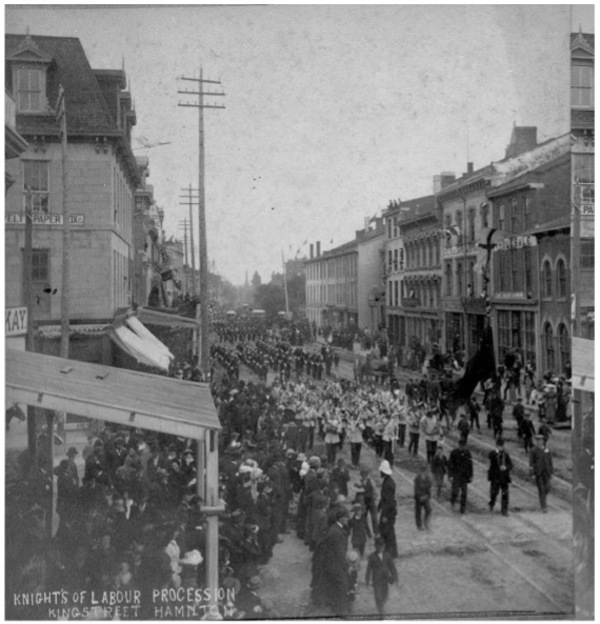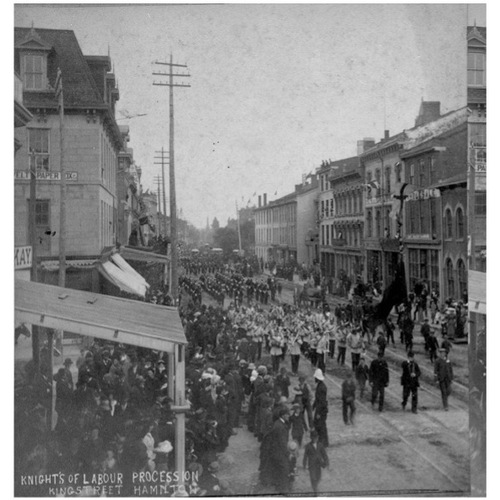
Source: Link
McVICAR, KATE (Katie), shoe worker and union leader; b. c. 1856 at Hamilton, Canada West; d. there 18 June 1886.
Katie McVicar, daughter of a poor Scottish tinsmith and his English-born wife, joined two older sisters in the Hamilton labour force in the early 1870s. Like most women who went into factory work in the late 19th century, she began as a single woman, living at home, in order to augment her family’s income. However, unlike most, she remained single and continued to live at home until her early death at the age of 30. Her comparative longevity as a factory operative accounts to some degree for her emergence as a prominent leader in the Knights of Labor.
The Knights, with their broad vision of unionizing all workers regardless of gender, race, or level of skill, were extremely active in organizing women throughout North America. The order’s first local assemblies in Hamilton were created in April 1882, and by December it was actively trying to recruit women. The following year a series of letters appeared in the Palladium of Labor, the organ of the Knights of Labor in Hamilton, which spoke eloquently of the need to organize women in factories and domestic service, and described at the same time the sizeable problems involved in unionizing them. These letters were signed “A Canadian Girl,” probably a pseudonym for Katie McVicar. The author argued that the techniques used in organizing men – holding mass meetings, mounting platforms, and making speeches – would never work for women. Instead she appealed for a few courageous women to come forward and meet with their brother Knights to secure aid.
This plea was answered in the Palladium by “A Knight of Labor” who suggested careful, secret discussion among female shop-mates, until ten who favoured forming an assembly had been identified. At that point they should contact him through the Palladium. He would then arrange a secret meeting to explain the Knights’ principles to the women and to organize them formally into a local assembly. The order’s operation as a secret society made it a particularly valuable vehicle for women, he argued, since it allowed them to avoid public notoriety and thus would protect their modesty.
Women, under the leadership of McVicar, must have followed this advice. In January 1884, local assembly 3040, which included female textile workers and shoe operatives, was formed in Hamilton. In April of that year, the female shoe operatives split and formed their own Excelsior Assembly (local assembly 3179), the first local in Canada comprised exclusively of women, with McVicar as directress. Although the number of women who belonged to the two assemblies actually declined from 221 in 1884 to 67 in 1885, the Knights organized at least eight other women’s locals in Ontario in the 1880s and involved many other women workers in integrated locals. The first female representatives at the Trades and Labor Congress of Canada, beginning in 1886, were all Knights of Labor.
Katie McVicar’s leadership of local assembly 3179 gave her an unusual prominence in the Hamilton labour force and it appears that after her death other members of Excelsior were not willing to replace her. Local assembly 3179 applied in 1887 and 1888 for special dispensation from the parent body to allow a brother Knight from local assembly 2132 (shoemakers) to function as their master workman. McVicar’s death deprived the order in Ontario of one of the few capable female leaders who was willing to play a public role.
Catholic Univ. of America Arch. (Washington), Terence V. Powderly papers (mfm. at PAC). York Univ. (Downsview, Ont.), York Social Hist. Project, Data file on Hamilton Knights of Labor, Record of proc. of the General Assembly (Philadelphia), 1883–86. Trade and Labor Congress of Canada, Report of proc. ([Ottawa]), 1886–91. Hamilton Spectator, 19 June 1886. Journal of United Labor (Philadelphia), 25 April 1886. Labor Reformer (Toronto), 26 June 1886. Palladium of Labor (Hamilton, Ont.), 29 Sept., 6, 13, 20 Oct., 3, 10 Nov. 1883. Times (Hamilton), 24 June 1886. J. E. Garlock, “A structural analysis of the Knights of Labor: a prolegomenon to the history of the producing classes”
Cite This Article
Gregory S. Kealey, “McVICAR, KATE (Katie),” in Dictionary of Canadian Biography, vol. 11, University of Toronto/Université Laval, 2003–, accessed January 8, 2026, https://www.biographi.ca/en/bio/mcvicar_kate_11E.html.
The citation above shows the format for footnotes and endnotes according to the Chicago manual of style (16th edition). Information to be used in other citation formats:
| Permalink: | https://www.biographi.ca/en/bio/mcvicar_kate_11E.html |
| Author of Article: | Gregory S. Kealey |
| Title of Article: | McVICAR, KATE (Katie) |
| Publication Name: | Dictionary of Canadian Biography, vol. 11 |
| Publisher: | University of Toronto/Université Laval |
| Year of publication: | 1982 |
| Year of revision: | 1982 |
| Access Date: | January 8, 2026 |



